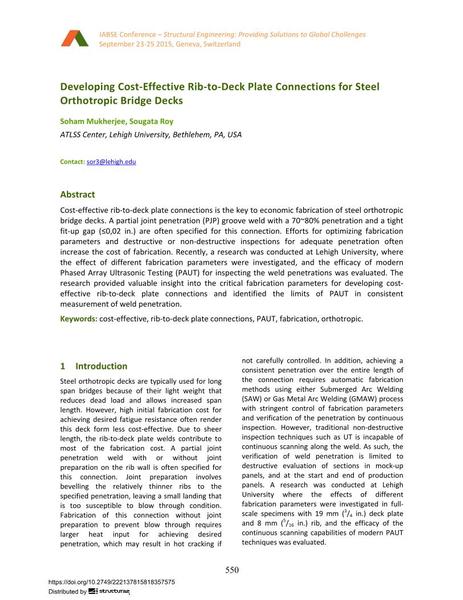Developing Cost-Effective Rib-to-Deck Plate Connections for Steel Orthotropic Bridge Decks

|
|
|||||||||
Détails bibliographiques
| Auteur(s): |
Soham Mukherjee
(ATLSS Center, Lehigh University, Bethlehem, PA, USA)
Sougata Roy (ATLSS Center, Lehigh University, Bethlehem, PA, USA) |
||||
|---|---|---|---|---|---|
| Médium: | papier de conférence | ||||
| Langue(s): | anglais | ||||
| Conférence: | IABSE Conference: Structural Engineering: Providing Solutions to Global Challenges, Geneva, Switzerland, September 2015 | ||||
| Publié dans: | IABSE Conference Geneva 2015 | ||||
|
|||||
| Page(s): | 550-551 | ||||
| Nombre total de pages (du PDF): | 2 | ||||
| Année: | 2015 | ||||
| DOI: | 10.2749/222137815818357575 | ||||
| Abstrait: |
Cost-effective rib-to-deck plate connections is the key to economic fabrication of steel orthotropic bridge decks. A partial joint penetration (PJP) groove weld with a 70~80% penetration and a tight fit-up gap (≤0,02 in.) are often specified for this connection. Efforts for optimizing fabrication parameters and destructive or non-destructive inspections for adequate penetration often increase the cost of fabrication. Recently, a research was conducted at Lehigh University, where the effect of different fabrication parameters were investigated, and the efficacy of modern Phased Array Ultrasonic Testing (PAUT) for inspecting the weld penetrations was evaluated. The research provided valuable insight into the critical fabrication parameters for developing cost- effective rib-to-deck plate connections and identified the limits of PAUT in consistent measurement of weld penetration. |
||||
